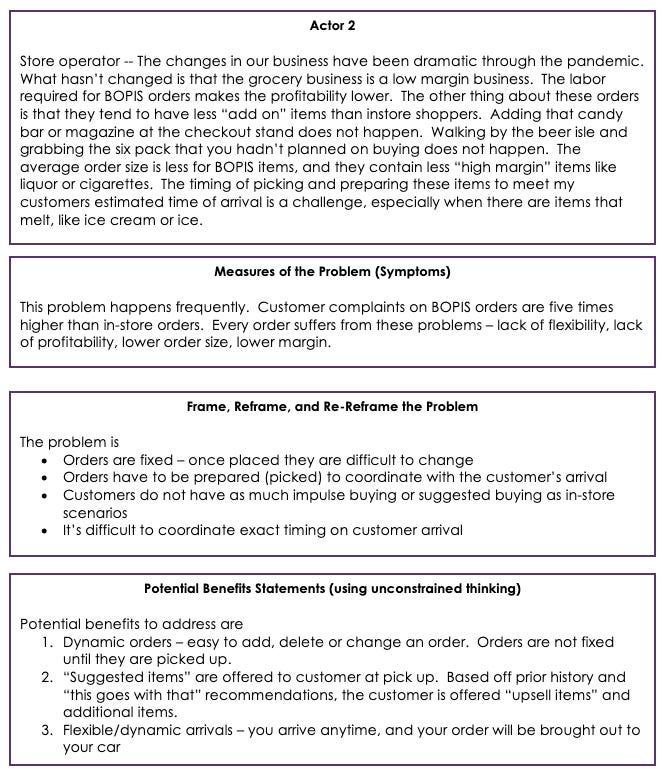To use a now-familiar refrain, “the pandemic has accelerated the future”. None has seen a bigger acceleration than online grocery shopping.
With the pandemic keeping consumers at home and away from stores (and restaurants), we estimate that total U.S. food and beverage e-commerce sales grew to $55.5 billion in 2020, up 81.1% year over year1
The most compelling use-case is “buy online, pickup at store” or “BOPIS”. This capability has a great potential customer experience, business model, and loyalty impact for grocery stores. But the operative word there is “potential”. My forecast is that current multichannel capabilities are akin to Fred Flintstone picking up his dinner order. Yes, it’s a car, but he uses his feet as brakes, and picking up the Brontosaurus ribs tips over his car! Yes, we have BOPIS, but the experience and business will both go through massive re-envisioning.
My broader thesis is that a lack of flexibility and lack of a dynamic recommendations process at ordering and pickup impacts every industry and they all need to develop multiple modes of delivery and service beyond the traditional. So this week’s edition of The Digital Leader Newsletter hopefully triggers deeper thinking and strategy beyond grocery and retail.
A Sustainable Business?
The impact to store operations and profitability from online shopping is significant. Online orders are smaller in total basket size, have lower margins, demand more labor, and disrupt the flow and experience of in-store customers and operations.
Traditional grocers that do their own online order picking from their physical store network (and provide delivery without any customer fees) are typically suffering a negative operating margin of about –15%, or –11% if they pick from a “dark” store that’s not open to the public. If a third party (such as Instacart in the US) does the picking from a regular store, the margin is likely to be about –5%. The bleeding is less severe for click-and-collect services, because they avoid the “last mile” logistics challenge that bedevils delivery services. The margin is likely to be about –5% for a grocer that does its own picking from a regular store without charging a fee. Click-and-collect orders picked from a dark store or by a third party should break even.2
Thus, in any of the multi-channel scenarios, these transactions, and customers, as currently architected, are not sustainable. How do we “run to the future” if the future has a negative margin?
A Reminder — The Strategy of “What Sucks???” -- Stay in the Problem Space a Bit Longer
A fair question would be “why have three question marks (???) after “what sucks”. Wouldn’t one question mark do the job? I put three question marks in “What Sucks???” as a reminder. The reminder is to slow down and stay in the problem space for just a while longer. In The Lean Product Playbook, the author, Dan Olsen, writes “the problem space is where all the customer needs that you’d like your product to deliver live” and the “benefits of problem space thinking: having a more accurate understanding of the market in which your product is really competing”.
I would propose, and hope to demonstrate to you over time, that the benefits of staying in the problem space a bit longer include improving the ability to develop a compelling value proposition, quicker identification of what the “killer feature” might be, accelerating the definition of your ideal customer segment, and a better initial understanding of priorities of concepts or features to test.
My natural inclination, like many “experts”, is to rush to a solution. The strategy, or the reason why we spend the extra time and effort of playing “What Sucks???” is that it helps us explore and gain better insights into our customers and the real problems they face before we jump to potential solutions. Doing this deliberate act of slowing down feels like a tax or drag, but makes a tremendous difference in the ideas and options we will consider, and thus, is actually a catalyst for true problem solving and innovation.
What Sucks??? Problem Canvas for BOPIS
By studying the problem space in a structured, unconstrained, customer-centric manner (start with the customer and work backwards), we come to some different observations and this will fuel better strategies and solutions.
Homework
Yes, there’s homework! What are the multichannel scenarios you do or should offer to your customers? Is the customer experience really what it should be offering flexibility and discovery? Are you having to compromise profitability to enable the capabilities? Apply the What Sucks??? Problem Canvas and stay in the problem space longer!
Download the What Sucks??? Canvas by clicking on this button
About The Digital Leader Newsletter
This is a newsletter for change agents, strategists, and innovators. The Digital Leader Newsletter is a weekly coaching session with a focus on customer-centricity, innovation, and strategy. We deliver practical theory, examples, tools, and techniques to help you build better strategies, better plans, better solutions — but most of all to think and communicate better. You’ll be able to follow up with questions and advice.
Here’s the value proposition for The Digital Leader Newsletter. Hope you join.
https://www.supermarketnews.com/online-retail/online-grocery-shopping-grows-amid-pandemic-induced-channel-stickiness
Bain & Company, “How to Ramp Up Online Grocery — without Breaking the Bank”






